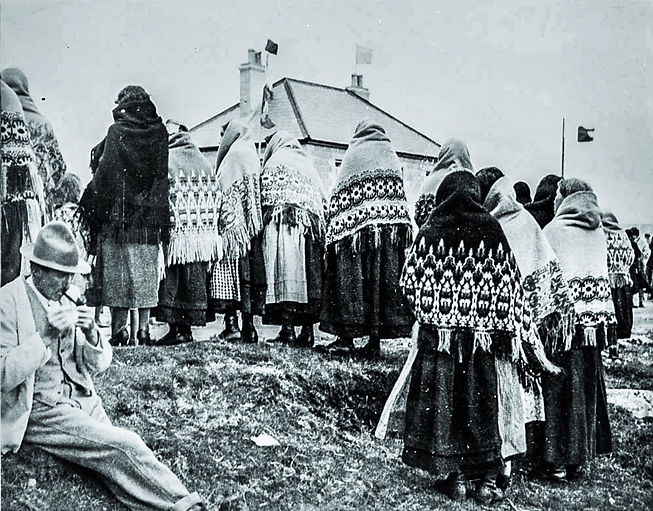Lou Brennan
Ireland
The Story

THE IRISH/GALWAY SHAWL
There's a mystery that surrounds these late 19th/20thcentury shawls, a poetry, so much history and emotion. The story is believed to have started in Ancient Babylon, with the creation of the curved teardrop/ pine cone motif, often referred to as "buta/boteh". The story travelled through a small town called Paisley on the west coast of Scotland, later moving onto the west coast of Ireland.
These heavily stylised patterned shawls, often with Paisley motifs, were to widely become known as Galway shawls. Intended mostly for the Irish market, they were woven on a hand Jacquard loom, with a cotton warp and a weft of botany wool. The shawls were reversible, with a deep decorative border in many colours and a solid colour in the centre. They were also the last styles to be woven in Paisley before the looms fell quiet in the 1940s.
Many eminent dress historians were not aware of these shawls, known by weavers as "fur" or "velvet" shawls. They owe their name to the soft, velvet like finish called a "nap". The effect was achieved after the woven cloth was specially milled to give the shawl’s surface a raised appearance. The fringing was reportedly the only design element added in Galway.

“…A Mystery…Surrounds These Late 19th/Early 20th Century Shawls, A Poetry, So Much History And Emotion. A Story Believed To Have Started In Ancient Babylon”


It was a quote from the painter Paul Henry that in part inspired me to create this collection. After time spent on Achill Island, he wrote that the women's dresses, "always supplied a rich note of colour...paisley shawls with elaborate designs...gave them an almost oriental appearance".
Many beautiful images are to be found in Grace Henry's paintings of women wearing their patterned shawls. They were extremely eye catching and costly items, considered "Sunday best" by many. Some were acquired by new brides and handed down as heirlooms.
Equally inspiring is a photo taken of a Mayo woman on Market Day in Foxford 1912, wrapped in her distinctive heavily patterned shawl. Later in the 1930’s photographer Branson DeCou, captured images of a vanishing Ireland with his hand tinted images of women in their distinctive Galway shawls. These beautiful photographs were predated by those of the philanthropist Albert Kahn. Of particular note is that of the young girl, Main Ni Tuathall, in a red cloak, taken in the Claddagh in 1913.
It is in the spirit of these shawls, often with lace borders, that I have hand drawn and painted motifs from my Carrickmacross wedding veil. This Irish lace has of course become synonymous with Ireland’s textile heritage. The Irish lace story is imbued with an emotion, history and legacy that inspires others to this day. I have taken the Paisley lace motif and repeated/arranged them in much the same way as the original woven shawl designs.

I have created a range of luxuriously proportioned silk blended scarves with a soft fringing and a range of limited edition silk scarves with hand rolled edges expertly finished in the studio here in Mayo.
The wool scarves are reversible, made with the softest 100% merino wool and knitted in a family owned mill in the West of Ireland.
The pocket squares are presented in a luxury gift box with accompanying cloth bag.
To protect the scarves they are beautifully packaged in a cloth bag embroidered with a woven label with an Irish saying,
'An rud is annamh is iontach'
'What is seldom is wonderful'




